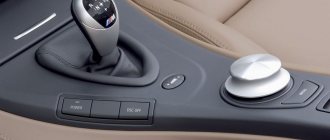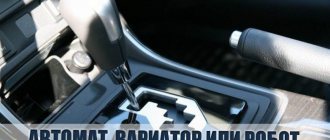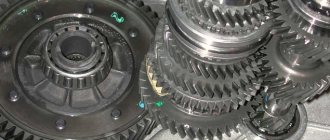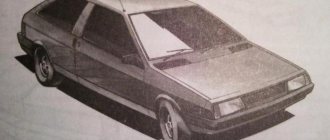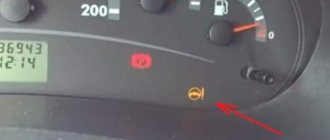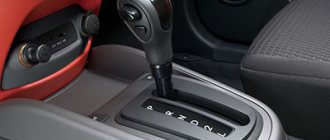PryazhonovPodbor › Blog › Checking the variator (CVT) of a used car
Friends, hello everyone!
First of all, I congratulate everyone on the new year 2017! Hurray! :)) And secondly, today I want to share with you information about CVTs, namely their testing on a used car. CVT, Continuously Variable Transmission
Everyone has long known that variators are structurally a system of two cone-shaped pulleys connected to each other by a belt drive. Each pulley contains a pair of cones directed towards each other, the mutual approach or distance of which during engine operation leads to a change in the radius of movement of the V-shaped closed belt or chain. Due to this, the change in gear ratio occurs smoothly.
CVTs are most widely used on cars of the Renault-Nissan concern. The unit is manufactured in Japan, and the most common model is JF011E. Among the Nissans, the X-Trail (T-31 body), Qashqai and Teana can boast of this CVT. Renault has Latitude, Koleos, Megan, Scenic and Fluence. In addition, Mitsubishi uses Jatko CVTs on the Lancer and Outlander models. They are also installed on the co-platform French crossovers Citroen S-Crosser and Peugeot 4008. But that's not all. "Suzuki-Kizashi", "Dodge-Caliber" and "Jeep-Compass" - they also have a Jatko variator!
Now closer to the point - what to look for when inspecting a car
with this type of gearbox?
The first thing that should make you wary is the jerking
of the car during acceleration. Ideally, the car should pick up speed smoothly (such as an electric car or trolleybus) at constant engine speed. If jerks or dips are clearly noticeable, then first of all you need to check... the engine itself. The variator may have nothing to do with it. But if the engine is known to be in good working order and runs smoothly, but the car still jerks when accelerating, then this most likely means that the variator is on its last days (months at best).
Next, we look at the engine speed during uniform movement: at a speed of 80 km/h, the tachometer needle should show approximately 2000-3000 rpm. If the arrow goes off scale beyond the 4000 rpm mark. per minute, then the variator is faulty. A clear indication of a breakdown will be an attempt by the engine to stall when braking. In this case, transmission repair is not far off and it is better to refuse to purchase such a copy. It would not be superfluous to check the level and condition of the oil poured into the variator.
Continuously variable transmissions are very susceptible (much more than automatic transmissions) to oil starvation. Therefore, the level must be normal. Black oil is unacceptable. This means that there is no point in changing it - the variator needs to be disassembled and repaired. To be sure, CVT experts advise dropping some oil onto a white sheet of paper and holding the resulting stain up to the light. It may be yellow or red
, but in no case brown or brown-black. Even if the seller (trying to hide signs of wear on the variator) changed the oil, the burning smell will still remain. It smells burnt - there is no need to continue the diagnosis.
Signs of CVT failure (for all types): noise, grunts, rumble (reminiscent of a faulty TAZ rear gearbox). How to diagnose: turn off the air conditioning and music at speed
60 from mode D to N and listen to the sound source. Most often, sounds are produced by bearings, being one of the most loaded elements. Be sure to check how the car moves at a constant speed, incl. in cruise control mode!
The most common malfunction of a variator is wear of the cone bearings, accompanied by a characteristic hum. Sometimes, during diagnostics, the noise of the variator is attributed to the front wheel bearings - and they are replaced with new ones, but the noise does not go away...
The first symptoms may appear already after a mileage of 50,000 km. Replacing four bearings with spare parts will cost 35,000 - 40,000 rubles. Most often, Nissan Qashqai suffers from this disease, less often - X-Trail, and least of all - Mitsubishi Outlander. With the latter, by the way, this happens at a much higher mileage: 150,000–200,000 km.
There are several reasons that lead to bearing noise. The first is that wear products fall on the working surfaces and accelerate their destruction. Two oil filters and a magnet for collecting metal powder are not able to provide a barrier to insidious wear products. Reducing oil change intervals to 30,000–50,000 km can extend bearing life. But there is no consensus even among experts, and the statistics on oil are ambiguous. There are many examples when one variator takes care of 100,000–120,000 km and remains quiet, while another in similar operating modes hums mercilessly after 50,000 km. This leads to the second reason - unstable quality of bearings. Third, bearings cannot withstand loads and are destroyed due to their low accuracy class and low dynamic load capacity.
The most serious and materially costly defect of the above is the defect of the variator transmission. It occurs when the belt slips between the pulley cones with the simultaneous formation of scoring at the ends of the belt segments and the working surfaces of the cones. This problem can only be eliminated by complete replacement.
Don’t forget to inspect the variator radiator (if there is one), check the oil level when cold and when hot (it should be different). Perhaps that's all I wanted to say in this entry. I am sure that you can buy a car with a CVT only after a good check and MANDATORY (!) computer diagnostics. It is necessary to take into account the indicator of the oil aging counter in the variator. This is a kind of indirect sign of the actual mileage and attitude towards the car.
Buy only proven used cars. Bye
What do we need for this?
- Vision and hearing are the main tools when checking not only a CVT, but also a used car in general.
- A clean paper napkin or rag.
- Cheap car scanner ELM 327 ODB 2 format and installed software.
The first point is needed to conduct a visual inspection of a static car and check it by ear while driving. A napkin is useful for wiping your hands and monitoring the quality of the oil in the variator. ELM is needed to scan the parameters of the CVT transmission during a test drive.
Before describing in detail all the stages of checking the variator before buying a car, I will provide several useful links:
https://disk.yandex.ua/d/ETAQFNEwd7jAQQ – link to the CVTz50 mobile application for Android. In the playmarket they demand money for it, but here you can download it for free.
ELM 327 will not be compatible with CVTs on pre-2002 vehicles. The application will not be able to connect normally to the control unit. In this case, you need to use the official Nissan Consult.
https://disk.yandex.ua/d/QkrmaMTOmkheiw – link to the Qashqai manual in the J10 body (in English). Do you check the CVT before buying a used car from another brand? – download your instructions. They are easy to find on the Internet and are freely available. This will be useful to know the permissible values of a particular CVT transmission.
If any link doesn't work, let me know in the comments.
We’ve decided on the software and the necessary tools, let’s begin testing the continuously variable transmission of the Nissan Qashqai.
I recommend: Buy a used Nissan Xtrail or what a future owner can expect from a used car
How to check the variator when buying a car
Modern cars are equipped with various gearboxes. The most common variations are mechanical and automatic, supplemented by a robotic transmission and a CVT. Motorists who are looking at a German or Japanese car with a CVT gearbox should know how to check the CVT when buying a car. Most often, a CVT is found on Honda or Audi cars, but sometimes on cars of other brands.
Visual inspection
We take our eyes and open the hood. We are interested in two things here:
- External condition of the gearbox;
- The condition of its cooling radiators.
If the engine is located transversely, then the gearbox is on the left side if you stand with your back to the car. We inspect the transmission from above, especially the place where it connects to the engine.
We pay attention to the color of the sealant and the method of its installation. The factory uses pink sealant and it is laid neatly so that excess does not hang out on all sides. If the variator was removed from the engine, then, in most cases, the sealant is gray. No one will bother using factory sealant, it is expensive.
The junction of the box with the internal combustion engine must be dry. Any oil leaks indicate possible problems. When visually checking the variator, it should be completely dry on top. If there is a lift, we inspect this place from below. It should be dry there too.
We look at the condition of the transmission oil cooling radiators . In some models, automakers make do with a heat exchanger, but in our case they are there. The first radiator is located behind the left headlight at the bottom, not to be confused with the engine radiators.
There should be no oil stains or leaks on it. The same applies to its fittings and transmission cooling hose. It is difficult to look into this place from above; it is better to inspect from below on a lift or inspection pit.
Caring owners install an additional cooling radiator. It is located in front of the engine cooling radiators. We inspect it for oil leaks.
If an additional radiator is installed on the car, this is a sign of the caring attitude of the owner.
Content
A CVT is similar to an automatic gearbox in that you do not need to set the speed yourself using the transmission lever. However, in its operation it has significant differences: if the “automatic” includes fixed gears, usually in the number of four to nine, then the variator is a continuously variable transmission that does not have fixed steps.
In other words, if an automatic transmission alternately includes fixed stages, then the variator works from the lower to the upper threshold, without having intermediate “stops” on the way to increasing the gear ratio.
So, in what ways can the variator be checked if you have already met with the seller and are inspecting the car:
- Checking the oil in the variator;
- Check in motion;
- Sound check.
The second and third methods may seem similar, but they are only adjacent; one may not give a complete picture without the other.
Despite the fact that a standard “automatic” with a torque converter is considered the preferred transmission option, a variator is considered more modern, although it is not without its flaws and shortcomings, and in some ways is inferior to an automatic transmission.
Let's talk in more detail about ways to check the variator.
How to understand whether the variator in a Nissan Qashqai needs to be replaced: primary diagnosis
Diagnosis of the Nissan Qashqai variator is carried out after pre-warming the car while driving. A number of operating instructions indicate the need to connect Consult and check the temperature sensor in the transmission. In this case, the voltage in it should be no more than 0.9 V. That is, before starting the checkpoint check, you should drive the car several kilometers. Self-checking the need to replace the variator box in the Nissan Qashqai consists of sequentially performing the following steps:
- warming up the car while driving;
- disconnecting electricity consumers from the battery;
- using a working battery whose charge exceeds 12 V;
- absence of an alarm system that breaks the standard circuits;
- setting the transmission lever to position “P” – Parking.
Transmission diagnostics are performed as follows:
- The key is inserted into the ignition switch and turned to the “ON” position. After warning lights appear on the dashboard, turn the key to the “OFF” position. Quickly repeat this action two times, leaving the car on.
- The ignition is turned on when the transmission lever is in the “P” position. After the CVT (Sport) warning light appears on the instrument panel, wait a few seconds, then turn off the ignition.
- Depress the brake pedal, shifting the gearshift lever to position “D” – Drive.
- After this, turn on the ignition again.
- Release the brake pedal and switch the lever to the “N” position.
- When pressing the gas and brake pedals simultaneously, switch the lever to position “D”.
- Release both pedals.
After the 2-second starting pulse, the indicator light will start flashing. It will be necessary to evaluate 10 flashes, some of which will be short (about half a second), some longer (about a second). Let's consider the option in which the self-diagnosis process was not activated.
How to change the oil in a Toyota Rav 4 variator with your own hands?
If the Nissan Qashqai variator is in constant emergency mode, it is necessary, first of all, to check the Step Motor windings located on the transmission connector under the battery. This connector allows you to evaluate the condition of all internal electronic components of the box. If you need to replace them, you will need to drain the oil and remove the pan with filter.
In case of complex malfunctions that require replacement of the Nissan Qashqai 2.0 variator, but do not appear every time while driving, measurements are taken from external speed sensors while driving. On most passenger cars, the connector can be found in the central part of the dashboard; on minivans it is located closer to the left pillar of the car under the glove compartment.
The emergency mode of the variator, both with a warm and cold engine, most likely indicates a Step Motor malfunction (winding breakage). If problems arise after the engine warms up, then most likely the problem is with the rotation sensor. In this case, the elements that impede access to the computer are dismantled. After dismantling, you need to drive the car for about 10 minutes, and then connect the device and evaluate the incoming signals.
If the variator is slipping, it is necessary to check the pressure in the port, as well as the existing voltage at the pressure sensor in the Stall Test mode. Such diagnostics will tell you what condition the Nissan Qashqai variator is in and whether it needs replacement. When buying a used car with a CVT transmission and significant mileage, it is worth replacing the gearbox during the next maintenance, preventing possible problems in the future.
Check in motion
Like many other components, assemblies and car parts, the CVT has a set of features that will tell you a lot, you just have to drive the car a little. If you meet the seller of a car equipped with a CVT, do not hesitate to ask him for a short test drive.
Ideally, of course, “drive” the car from the lower to the upper threshold. Simply put, if the car accelerates smoothly and without jerking to 180 kilometers per hour, this indicates the unequivocal serviceability of the variator. However, we do not recommend doing this unless you have a race track nearby and the car owner agrees to such a stressful test.
If the car jerks or does not accelerate smoothly, this indicates a malfunction. Most likely, the culprit is the oil pump, which is clogged with worn-out metal shavings from the wearing out variator mechanism. If it clogs the valves, the pump begins to jam, which leads to surges in oil pressure in the system.
The coherence of the movement of the pulleys is lost, the belt slips, and the car jerks. It is extremely risky to buy a car with such symptoms, because if the owner has driven in this mode for a long time, it is very likely that the gearbox will be quickly replaced, which is not cheap (on an Audi, the cost of the CVT itself is approximately 100 thousand rubles).
The variator belt itself is a set of metal plates, on which, for better adhesion to the pulleys, microscopic irregularities are applied. Mechanically, they are erased over time, becoming the very dust that can clog systems. If the box twitches, it is better to refuse to buy the car, and recommend to the owner to open the variator as soon as possible.
Technical elements of V-belt CVT
The elements of a V-belt variator include:
- clutch, which is responsible for connecting the engine with the transmission;
- torque converter;
- tapered pulleys;
- connecting chain (belt);
- an oil pump that creates the required pressure (in some cases, the operation of the cone elements is provided by hydraulics or a spring);
- a hydraulic unit that supplies oil to various parts of the drive and driven shafts;
- filters;
- radiators that take heat from the box;
- control system connected to the car's ECU;
- reverse device.
Sound check
As we have already said, although this method involves checking on the go, both methods will not necessarily give a positive result and will not necessarily give a negative result. Although these checks are carried out together, the outcome of each of them is independent.
So, the owner agreed to conduct a short test drive, and you sat behind the wheel, or even in the passenger seat - you don’t have to drive the car to check the sound. First of all, listen to the operation of the variator at idle - here you should only hear the engine, the box does not make any sounds at idle.
Based on the design features, the variator also does not make any particular sounds while driving. If the sound insulation of the car is not up to par, then you can hear a quiet and uniform sound of the variator, but in no case should there be sharp sounds such as clicks or an increasing howl - this indicates a malfunction of the box.
Some sounds may be due to worn pulleys. In this case, the car will make a hum while driving, and you should definitely listen to it, since the sound is very similar to the hum from worn out bearings.
Not catching this sound can be dangerous, however, its absence, although a reason for optimism, is still not so strong, since problems of this kind with the variator can arise at a variety of mileages - both at 50 thousand and over a hundred - this solves a lot the driving style of the car owner and the model of the car and the variator itself.
If you are not sure that these methods are for you, or you are afraid of missing something important when checking the variator, then you can apply for the Autocode on-site inspection service, and the specialist will inspect the car right at the place of purchase, or order a car history check using the VIN or state registration number. number to "Autocode". Thanks to the service, you will find out the actual mileage of the car and whether it has had an accident - the main points that will tell you whether it is worth taking a closer look at the car in principle, and in what condition its CVT transmission is supposed to be.
Replacing a CVT with an automatic
Having struggled with a problematic variator, many are starting to think about replacing the gearbox. For example, for an automatic transmission - after all, this brand of car has such reliable gearboxes. Compared to a CVT, an automatic transmission has the following advantages:
- good off-road performance;
- higher load capacity;
- less wear during aggressive driving style;
- great wear resistance.
However, the automatic is less economical than the CVT.
Replacement is not a problem if a particular model has an automatic transmission compatible with the engine type. The service is offered at most service centers.
***
The CVT is actually considered the weak point of such a generally reliable car as the Nissan Qashqai. However, there are also drivers who do not accept a transmission type other than CVT. Therefore, you should carefully read the available information, weigh the pros and cons before deciding which modification of the Qashqai to buy.
Device
This device on Qashqai has an English designation - CVT, and stands for continuously variable transmission. This is a variation, so to speak, of an automatic transmission. It’s difficult to immediately notice its peculiarity, since it has two pedals, the transmission modes, like the lever itself, do not differ much from a traditional automatic transmission.
The difference lies in its work itself. The Nissan Qashqai variator does not have a fixed first, second or tenth gear. He has a lot of passes. Switching between them is so easy and smooth that it is difficult to notice. Here you won’t be able to feel the shocks either when starting or when switching, since there are none. To put it more correctly, there are no switches at all. The car will not slip out of the blue. The device itself gradually and constantly changes the gear ratio when necessary: accelerating or decelerating the car.
Advantages and disadvantages
The main advantages of the variator are:
- general provision of favorable engine operating conditions;
- unlike a conventional stepped automatic, the variator does not put shock loads on the engine when switching to a lower gear for intense acceleration;
- due to smooth speed control, good fuel efficiency is ensured;
- With a working variator, the Qashqai practically does not slip on slippery or sandy soils.
However, along with the positive aspects, the variator also has weaknesses:
- complexity and relatively high cost of box maintenance;
- impossibility of using CVTs on powerful engines (more than 200 hp);
- not suitable for those who like aggressive driving;
- the variator is equipped with a complex electronic system with a large number of sensors and connectors, so the output of at least one of them puts the box into emergency mode;
- To service the box, you need to use only original oils and parts.
But if all the rules are followed, the Nissan Qashqai will show itself as a reliable and trouble-free unit.
- How to change the oil in a Nissan Juke variator with your own hands?
Loading …
Signs of breakdown
If it seems that there are breakdowns in the gearbox, it has started to work strangely, then self-diagnosis of the automatic transmission is necessary. There are the most common signs of a variator malfunction:
- There were a lot of slippages.
- A signal has been detected on the instrument panel, which indicates an emergency mode of the automatic transmission.
- Some drivers o. In this case, you also need to check the pillows.
- Jerks began to appear when shifting down or up in any gear. The car began to jerk both hot and cold.
- I began to feel some knocks in the transmission when the car was running. Kicks frequently or does not stop kicking at all.
- Braking often occurs, the transmission is “stupid”, clicks and makes noise.
Be sure to ask how to check the box. Diagnostics should be regular, at least you need to change the oil and filter on time, and sometimes you need to flush the valve body. And don’t forget that you need to check the oil level in the box yourself regularly, since overhauling it is not a cheap operation.
We do not recommend using a contract variator, that is, a used one, since it is a “pig in a poke”: you may get a good one, or maybe “barely alive”.
Check the oil level and condition
The oil level in the variator is checked with a hot or cold box and has two marks on the dipstick. The level is checked with the car running. Before checking, you need to press the brake and hold the selector in each position for 5-10 seconds. Below is a drawing of a probe in which two intervals are visible: the hot and cold zone of the marks. The oil level should be between the marks, depending on the temperature of the box.
The oil must be light, otherwise you will have to replace it yourself (the price tag for this work with materials is approximately 15 thousand or more), the ATF should not contain inclusions of metal shavings (if the particles are visible to the naked eye, then the oil change took place without removing the oil pan, and therefore: filters were not changed, magnets were not cleaned). Also, the oil should not have a burning smell, and overheating, as everyone knows, does not extend its service life. After purchase, be sure to replace the transmission fluid by removing the crankcase as described in this manual.
Reliability
Many 2016 Qashqai cars have CVT gearboxes from the Japanese Jacto plant. A good guarantee for the variator is given by the manufacturers of this device to those companies that buy them. For Nissan Qashqai, this plant provides a warranty service life of 120,000 km. But Nissan itself slightly underestimates the resource and gives a 100,000 km guarantee for all cars with a CVT, taking into account the fact that the entire car will work with the entire load, and not just the gearbox itself.
But according to experts’ calculations, the real resource of the CVT Nissan Qashqai is slightly longer than the official one. It ranges from 130,000 km to 200,000 km, but such a long and reliable service is only possible when the radiator is flushed in a timely manner, as well as correct switching (that is, a complete stop) and changing the transmission oil when required.
Naturally, if the load is increased, the reliability of the variator decreases, and with it the service life.
Continuously variable transmission Nissan (Jatco)
The Nissan automobile concern has developed Jatco boxes, which are now installed not only on brand models, but also on cars from other manufacturers. There are quite a lot of cars on the Russian (secondary) automobile market with a Jatco CVT, so it’s not difficult to get information about the reliability of the gearbox and their service life.
Statistics from official and independent service centers allow us to evaluate the reliability and service life of variators, the cost and feasibility of repair work, and the availability of spare parts.
When considering boxes, the emphasis will be on the CVT Nissan Qashqai, other models will also come into view. This will answer the question of whether the Nissan CVT is reliable.
CVT Nissan Qashqai j10, X-trail T31 (T32), Murano (Z50 and Z51), Teana
Jatco models JF010E and JF011E represent the second generation of continuously variable transmissions. The second is combined with 2 and 2.5 liter petrol engines, the first comes with a 3.5 liter engine. There are no differences in design; the first variator only has reinforced elements for higher torque.
The JF011E variator was installed on the Qashqai and X-Trail crossovers of the penultimate generation, as well as on the Mitsubishi Outlander (the last two generations). JF010E went to the Murano crossover (Z50 and Z51) and the Teana sedan.
The reliability of the Qashqai variator is beyond doubt, since the gearbox family in question is not distinguished by the presence of characteristic sores. The resource is about 150-200 thousand km. Once a Nissan CVT reaches the end of its life, its components are already critically worn out.
The advantage of CVTs is their maintainability. The cost of the latter is 150-180 thousand rubles. The concern produces a valve body or variator assembly for the spare parts market. You can find some spare parts on the market, others can be repaired. A new continuously variable transmission costs 200-230 thousand. If the resource allows, you need to choose this option.
Service
You should not neglect scheduled maintenance of your Nissan Qashqai 2.0, as this will help avoid possible problems in the future.
Planned maintenance consists of the following operations:
- Checking the external oil filter cartridge. If necessary, it is worth replacing, and this is done after 30–50 thousand km.
- Checking the oil level and itself. If necessary, it must be replaced, and the need for this occurs after 60–100 thousand km.
There is also work in the form of unscheduled maintenance. It is very difficult to make them with your own hands; you need to have good knowledge in this matter. Therefore, you should only list the work that can be carried out on your car. Basically it's replacing something:
- Internal oil filter.
- Speed sensor.
- The high pressure pump valve of the pump itself.
- Cones.
- Belt (sometimes a metal or rubber variator belt, sometimes a chain).
- Pump and axle shaft seals.
- Selenoidov.
- Friction clutches and sealing rings.
- Stepper motor.
- Shaft bearings.
If shifting gears is difficult, adjustment will be required.
Has the variator been repaired?
After checking the oil level and condition, you need to pay attention to the box fastenings. The factory marker on the bolts and nuts must be present. Pay attention to the presence of nicks and abrasions on the variator mounts. Compare the general condition of the engine compartment and gearbox; contamination should be uniform. If repairs were carried out, find out from the former owner the cause of the malfunction, and also ask for documents on the work done.
Also pay attention to whether the towbar is installed. Severe operating conditions under heavy loads contribute to increased wear and failure of the gearbox. I advise you to read the article about the correct operation of the variator
CVT price
Naturally, repairing a Nissan Qashqai CVT will be cheaper, otherwise no one in Qashqai would have repaired its CVT. Therefore, if CVT repair is possible, then it is better to repair it. There is no need to be greedy and repair it yourself, as it is very difficult and you do not have all the repair equipment. The service will do everything right. It is difficult to say how much the repair will cost, it depends on how the variator broke and why.
If the situation is dire, then you need to buy a new mechanism. The original CVT on a Nissan Qashqai costs 1,500 USD. e. This is the average cost, since on some machines it costs about 2000 USD. e., and on others - from 1000 USD. e.
Nissan Qashqai, checking the fluid level in the variator: how to do it yourself and not make a mistake
On a Nissan Qashqai, checking the fluid level in the variator (CVT) is easy to do yourself, anywhere and at any hour. One important condition is that the engine must be warmed up, i.e. you will have to travel at least 10 km. The thing is, the error can be too large, which will lead to wrong decisions and wrong actions. Overfilling, like underfilling oil, has its negative sides.
The fluid level is checked after warming it up to 50-80°C, i.e. in winter, the mileage before checking should be greater - up to 25 km. When taking measurements in the summer, in the heat, you should let the car sit for half an hour after the trip and cool down a little. In any case, the level should not be “cold” (after warming up the engine at idle), but rather “hot”, i.e. after running along the highway.
Features of driving with a variator
The most important principle of using this type of box is that you need to warm it up if the temperature outside is low. This is due to the fact that the oil used in it has its own special characteristics. When it's cold outside, the oil cools, it becomes viscous, and it takes time for it to spread throughout the entire transmission.
If you start moving when some of the elements are not lubricated, this can lead to breakdowns. For better variator service, warming up and oil distribution, it is recommended to warm it up like this: P–R–N–D.
To drive a CVT when there is severe frost outside, it should take about 30 minutes (at least) to warm up, and after that you can drive the car safely. But even when moving for some time, you need to follow certain rules. Operation during the first 5 km should be very careful, you should drive without sudden jerks. This is necessary so that the lubricant is distributed throughout the entire system.
An oil change is required every 40,000 km. Be sure to use only high-quality fluid, since the variator only works properly with it. On Qashqai, the variator has its own characteristics and “nitpicking” regarding the quality of the hydraulic fluid.
There are several rules when overtaking and turning in a Nissan CVT. This type of transmission responds to an increase in engine speed. Therefore, to change the gear ratio, you will need to increase the speed. Afterwards, the variator, following the selected mode, will perform the actions required of it, albeit with a slight delay.
Based on the same rule, controlled overtaking should be done when the speed has increased. And when you take turns, you need to press the gas exactly at the moment when you turn the steering wheel.
If you use the variator correctly, you can operate it for many years.
General information about the variator
The differences between a variator and other types of gearboxes are fundamental. The defining feature is the ability to adapt to the current conditions in which the moving vehicle is located. The box also constantly determines the desired gear ratio. The gear range is limited by the design features of the transmission, but within it the number of variations is almost endless. It is this feature that helps save fuel and optimize energy costs.
There are V-belt and toroidal variators. The first ones are installed on most cars. .
How does a V-belt continuously variable transmission work?
Structurally, the CVT V-belt box is represented by two pulleys - driving and driven. The master is connected to the car engine, the slave is connected to the wheel drives. The shafts are connected using a belt or chain.
The peculiarity of the pulleys is that they look like two halves of a conical shape, their vertices directed towards each other. The divergence and convergence of the cones changes the diameter of the single structure.
The operation of the CVT is as follows. When the car starts moving, the motor experiences a load. To reduce it, the cones of the drive shaft diverge and the diameter decreases. The opposite changes occur on the driven pulley - the cones converge, the diameter increases. As a result, the number of revolutions of the internal combustion engine becomes optimal.
An increase in speed has the following effect: the diameter of the drive pulley increases, and the diameter of the driven pulley decreases. The traction force is reduced, the operation of the motor is smooth. The electronic control unit (ECU) is responsible for the convergence/divergence of the bevel pulleys. The simplicity of the design makes the CVT powertrain less expensive than other transmission options.
Driving sensations
If, when you press the gas pedal, the engine speed increases, but the speed remains the same or changes slightly, this is a bell about the “dying” state of the transmission. During smooth acceleration, the engine speed should remain approximately in the same position, and the speed should gradually increase. If there are sudden drops or overshoots in engine speed, then the gearbox is in trouble.
Important. When you smoothly brake to zero and selector position “D,” you will feel a slight kick. This is inevitable, because at this moment the torque converter is unlocked. The push should be small, barely perceptible.
When checking the car's variator in motion, if you feel kicks during acceleration or a strong push when the speed is reduced to zero, this is a sign of an emergency condition of the gearbox. This applies to Nissan CVTs and Hondas, which use a clutch pack instead of a torque converter.
Let's not forget about hearing. While driving, no crunching or grinding noises should be heard from under the hood from the gearbox side. In Qashqai, sound insulation is at a low level, so the engine compartment will be clearly audible.
Cruise control
If the car is equipped with this function, turn it on and look at the engine speed and speed. They should not twitch or remain static.
Change the speed reference. The tachometer and speedometer should change smoothly, either increase slightly or decrease. Again, jerking and kicking are not allowed.
What causes a variator to break down?
The main cause of known malfunctions of CVTs is violation of basic operating rules:
- the oil or filter element was not replaced on time;
- use of low-quality oil;
- aggressive driving style;
- prolonged driving at maximum speed;
- sudden braking.
Additional causes of malfunctions can be various defects in structural components (defects, ill-conceived design, poor-quality connection), as well as natural physical wear and tear of the constituent elements, which manifests itself after 150,000 - 200,000 km.
CVT malfunctions can occur both in its electronic control module and in mechanical components.
Electronics defects
In the first case, detection of a specific breakdown is carried out using computer diagnostics. A diagnostic code is assigned to each defect. Thus it is easy to determine:
- problems with the electronic control module board;
- defects in the speed sensors of both pulleys, operating oil temperature, pressure in the main line or pulleys;
- malfunctions of the stepper motor, defects in the blocking valves of the hydraulic transformer and control of the operation of the planetary gearbox, solenoid valves for pressure in the main line and the driven pulley.
The probable cause of a defect in the electronics may also be a violation of the integrity of the electrical wiring or unreliable contact in the connector.
Mechanical problems
Computer diagnostic tools are not the only tools used to detect mechanical problems. In this case, it is necessary to approach the problem in a comprehensive manner and monitor the parameters of the working fluid, conduct road tests, read the diagnostic code, and clarify signs of malfunctions.
Smooth ride
Also quite a common problem with the variator is the appearance of jerks and jumps during operation. The cause of this breakdown is the oil pump pressure reducing valve. In some positions it begins to jam due to worn particles that pass onto the functional surface.
As a result, we have incorrect system pressure, and for this reason, the pulleys stop working smoothly and the belt begins to slip. If you catch the moment at which all this starts to happen and go to the service center as early as possible, you can polish the pulleys, however, the belt still needs to be changed, but this procedure will cost much less (60,000-80,000 rubles), than in a neglected state (more than 100,000 rubles).
Variator oil
You can try to pull out a stalled vehicle by rapidly changing the position of the lever from D to R and back, but with this method one more fact should be taken into account - the movements when moving the lever from the “parking” position to D and R. Due to this, splined wheels wear out especially badly contacts of the planetary clutches, and they interact with the friction discs.
Therefore, a pause is necessary, and optimally, stopping the car when changing from D to R and back. Otherwise, as a result of such actions, it is necessary to replace the planetary gear. Drivers often think that the reason is the valve body, but it is of very high quality for CVTs.
